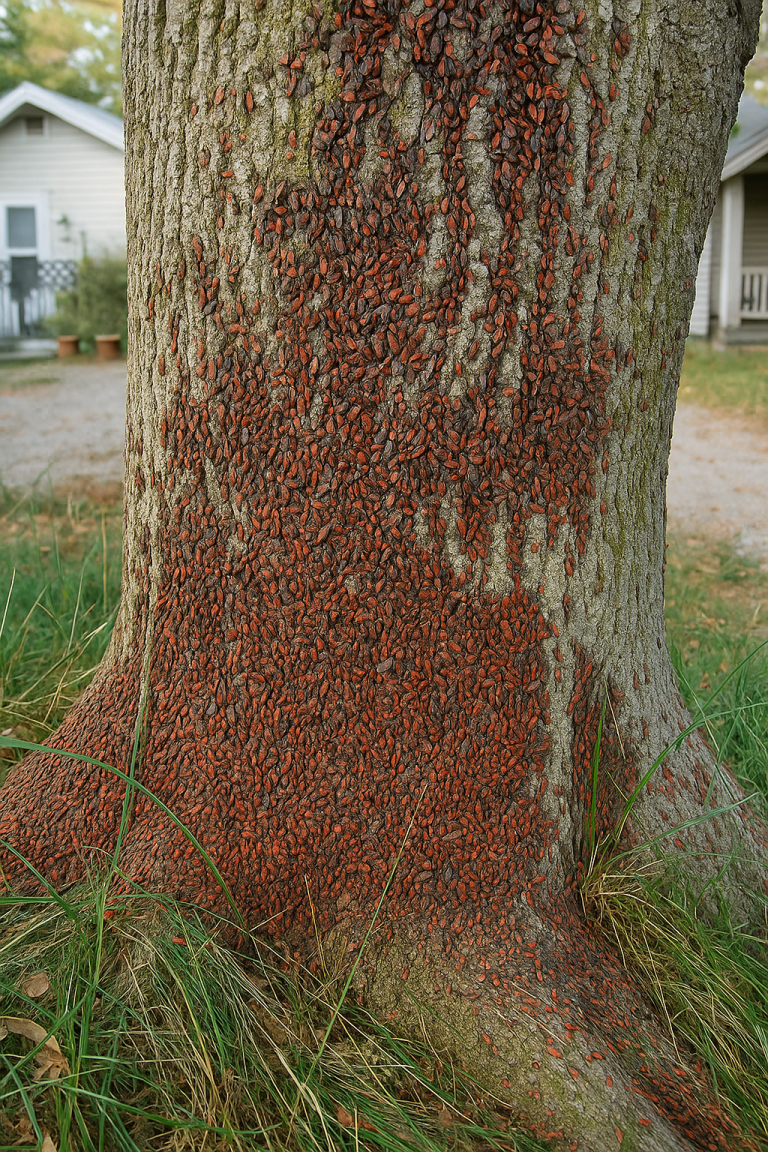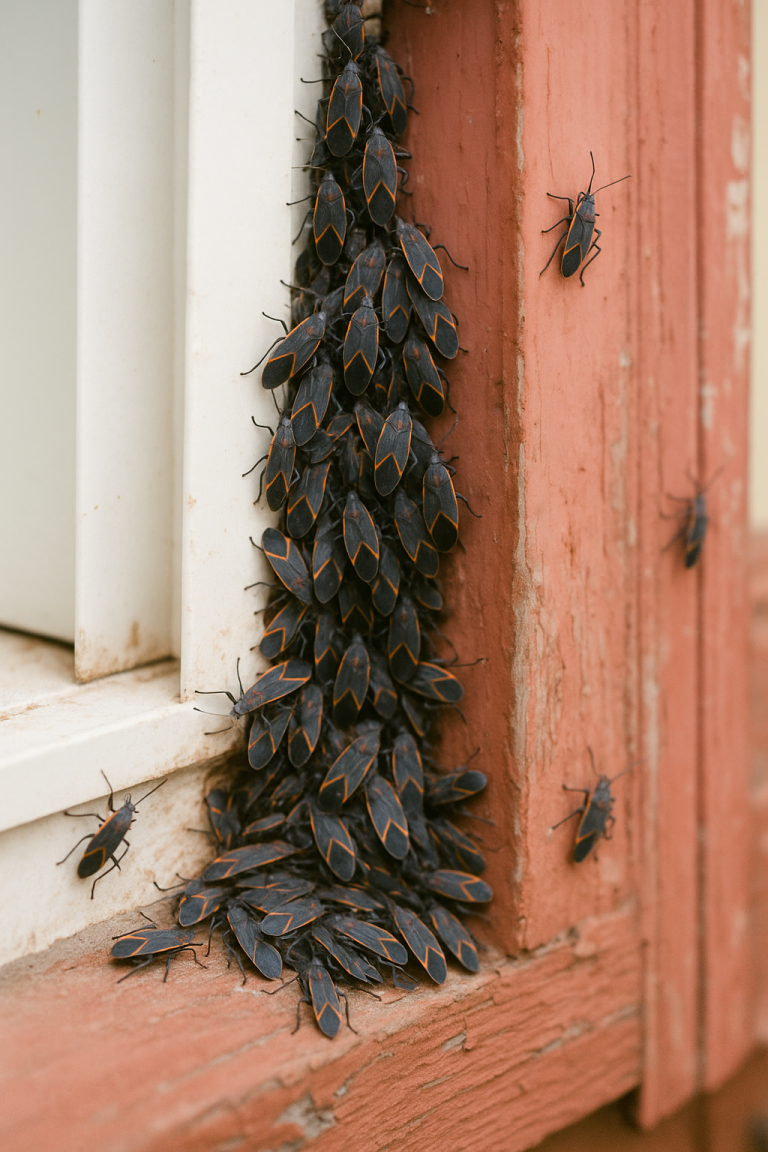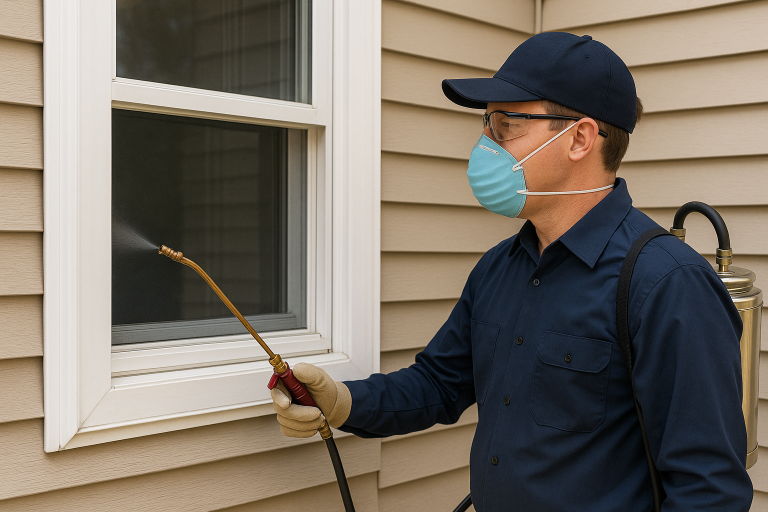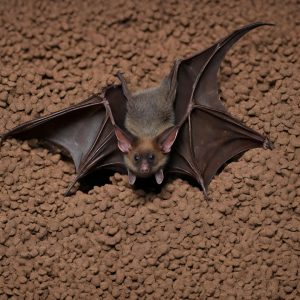Every fall, homeowners across Hamilton, Ontario begin noticing clusters of small black-and-red insects gathering on sunny exterior walls, around door frames, and especially near windows. These insects are boxelder bugs, and while they are mostly harmless, they can become a major nuisance as temperatures begin to drop. Their sudden appearance often leaves homeowners wondering where they came from, why they’re congregating in large numbers, and what can be done to keep them from entering the home.
Hamilton’s neighbourhoods all experience seasonal boxelder bug activity. Understanding their behaviour and knowing how to respond can help homeowners reduce infestations and keep them out of living spaces.
What Boxelder Bugs Look Like
Boxelder bugs are easy to identify once you know their appearance. Adults have elongated bodies about 12 to 14 millimetres long. Their colouring is a deep grey or black with bright red or orange markings along the wings and thorax. Nymphs, which are younger versions, are smaller and more vibrant in colour, appearing mostly red with dark patches.
Homeowners usually notice them on the warmest side of the home, particularly the south or west-facing walls during sunny fall afternoons.

Why Boxelder Bugs Appear Every Fall in Hamilton
Their seasonal behaviour is tied closely to temperature changes. During spring and summer, boxelder bugs feed on seeds, leaves, and sap from boxelder trees, maple trees, and sometimes ash trees. Hamilton has an abundance of these tree species, especially in neighbourhoods near the Escarpment and older urban areas where mature maples dominate residential streets.
Once fall arrives, their natural food sources begin to dry up, and temperatures start to drop. This triggers a migration toward warm, sheltered spots where they can overwinter. Homes, garages, sheds, and exterior cracks offer ideal protection from the cold.
Why They Gather Around Windows
Many homeowners first notice boxelder bugs congregating around exterior windows in September, October, and early November. Their attraction to windows is caused by a combination of heat, reflection, and structure.
Heat From Sunlight
Windows and surrounding trim retain heat when the sun hits the home. Boxelder bugs are cold-sensitive, so they cluster on warm surfaces in the late afternoon.
Reflective Glass
Glass reflects warmth and light, which confuses boxelder bugs. They often mistake this reflection for a light source or warmth source, causing them to gather in large groups.
Access Points Near Frames
Window frames commonly contain small cracks or openings. As boxelder bugs search for shelter, they naturally move toward these potential entry points.
Even though boxelder bugs prefer the exterior, they often slip indoors through tiny openings around windowsills or damaged screens.
Why Hamilton Homes Experience Heavy Activity
Hamilton’s combination of mature trees, older homes, and warm fall afternoons makes the city a hotspot for boxelder bug activity.
Several factors contribute to increased seasonal presence:
Abundance of Maple and Boxelder Trees
Older neighbourhoods such as Kirkendall, Stinson, Durand, Crown Point, Beasley, and Westdale have high concentrations of mature maple trees. These trees provide the perfect feeding environment for boxelder bugs during spring and summer.
Warm South-Facing Brick Walls
Hamilton’s brick homes retain warmth well into the evening. Boxelder bugs are naturally drawn to these heated surfaces.
Older Window Frames and Siding
Many Hamilton properties were built decades ago, and aging materials often contain gaps that allow boxelder bugs to enter or congregate.
Escarpment Microclimate
Areas near the Niagara Escarpment experience slightly warmer fall temperatures and more sun exposure, extending bug activity later into the season.
Are Boxelder Bugs Dangerous?
While their presence can be frustrating, boxelder bugs are not harmful to humans or pets. They do not bite, sting, or cause structural damage. Indoors, they do not reproduce or infest food.
Their main issue is annoyance. When large numbers gather on siding or enter the home, they create a nuisance for homeowners trying to maintain a clean living environment.
Though they do not destroy structures, they can leave rusty-coloured stains on curtains, walls, or surfaces if crushed.

How Boxelder Bugs Enter the Home
If boxelder bugs gather in large numbers on the outside of the home, some may eventually slip indoors. They most commonly enter through:
- Gaps around window frames
- Torn or poorly fitted screens
- Cracks in siding
- Vents without proper screening
- Gaps under exterior doors or garage doors
- Openings around utility lines
Once inside, they tend to gather in warm, sunny areas such as south-facing windows, patio doors, or light fixtures.
How to Prevent Boxelder Bugs From Entering Your Home
Preparation is the best way to prevent these insects from taking shelter indoors when fall temperatures drop.
Seal Cracks and Gaps
Examine the exterior around windows, doorframes, siding edges, attic vents, and foundation seams. Seal noticeable gaps with weatherproof caulk.
Replace or Repair Damaged Screens
Even a small tear in a window screen gives boxelder bugs an entry point. Repairing screens before fall significantly reduces indoor sightings.
Install Door Sweeps
Exterior doors that let in drafts also let in insects. Door sweeps help seal the bottom gap.
Protect Vent Openings
Dryer vents, soffit vents, and attic vents should be covered with fine mesh screening to prevent insect access without restricting airflow.
Reduce Outdoor Attractants
While it isn’t practical to remove large maple or boxelder trees, trimming branches close to the home can reduce bug migration toward windows and siding.

Do Sprays Work Against Boxelder Bugs?
Boxelder bugs are not heavily affected by DIY sprays once they are established outdoors. Their protective outer shell gives them resistance to many household insect products.
Professional treatments are far more effective because they target the areas where boxelder bugs gather and move along the home’s exterior. When applied correctly, these treatments create a barrier that reduces clustering and prevents insects from using cracks to enter the home.
Most homeowners see the best results when exterior treatments are applied in early fall before activity peaks.
What to Do If Boxelder Bugs Get Inside
If a few boxelder bugs make their way indoors, they can usually be removed without chemicals.
Use a Vacuum Cleaner
Vacuuming is the safest and easiest method. Dispose of the vacuum bag or empty the canister outside.
Avoid Crushing Them
Crushing boxelder bugs can release a foul odour and leave stains.
Keep Interior Lights Dim at Night
Bright lights attract insects, especially if gaps around windows are present.
If hundreds are entering the home, the issue is almost always linked to exterior entry points that need sealing or professional treatment.
When to Call a Professional
Boxelder bugs gather in large numbers every fall. It’s time to contact a pest control technician if:
- You find clusters inside the home or attic
- Exterior treatments have never been done
- Window frames or siding contain many small cracks
- The home is older and difficult to fully seal
A technician can identify the exact entry points, provide targeted exterior treatments, and help reduce seasonal clustering year after year.

Managing Boxelder Bugs in Hamilton Homes
Boxelder bugs may be harmless, but they are among the most noticeable and persistent fall nuisance pests in Hamilton. Their seasonal behaviour, combined with the city’s mature trees and older homes, makes them a common annoyance each year.
By sealing entry points, repairing screens, trimming vegetation, and scheduling timely exterior treatments, homeowners can significantly reduce boxelder bug activity and keep them from moving indoors as temperatures cool.
For help managing boxelder bugs around your home this fall, Elite Pest and Wildlife Removal provides professional exterior treatments and preventative solutions across Hamilton, Ancaster, Stoney Creek, Dundas, Burlington, and surrounding communities.
To book a fall treatment or inspection, call 226-208-7793 or visit elitepestandwildlife.ca.


